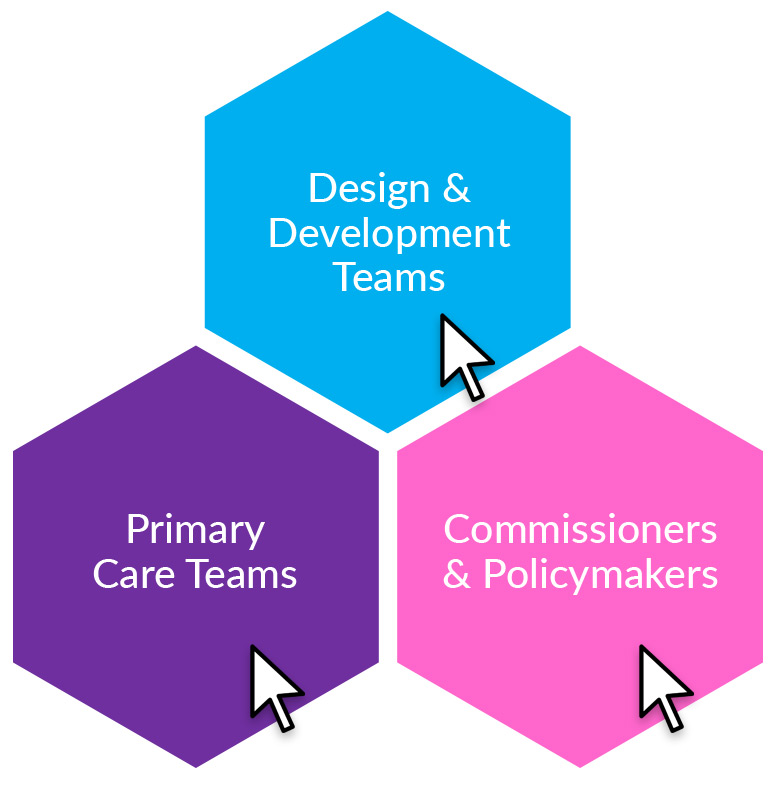Recommendations for the implementation of Clinical Decision Support Systems
Our systematic review on barriers and facilitators of Clinical Decision Support Systems (CDSS) for early detection of diseases in primary care has highlighted key recommendations for different groups of stakeholders. Have a look below or download the recommendations here: Recommendations PDF.
The systematic review is published here: https://doi.org/10.1186/s13012-025-01445-4

Design & development teams
Integrate CDSS with existing Electronic Health Record (EHR) and IT systems
- Ensure data security
- Update technology automatically
- Work with clinical software companies to ensure complete, error-free integration
Align CDSS with current practice and complex workflow
- Ensure CDSS is efficient, flexible and timesaving
- Integrate patient facing and primary care team components along the primary care pathway to enable easy documentation and monitoring
- Build CDSS for complex interrupted workflows
Ensure front-end usability by developing simple, intuitive and attractive CDSS
- Use consistent, appealing and high-quality graphic displays with good structure and visualisation, familiar format and clear wording
- Create a simple navigation through few screens that hides redundant information and uses auto-population of fields
- Provide passive, non-intrusive prompts with acceptable frequency that are easy to address
- Show results as clear, objective, quantitative percentage score with interpretation aids adjusted to users’ levels of education and skills
Support adaptability
- Provide technical FAQs within the system
- Address technical challenges to improve functionality
- Update with new guidelines and IT changes
Design CDSS for appropriate diagnostic challenges
- Select conditions that are challenging to diagnose and manage in every-day primary care
- Align CDSS with existing evidence-based clinical guidelines
- Consider using CDSS to support professional skills development and clinical judgement (e.g., in LMICs)
Engage stakeholders early and throughout the developmental process
- Include institutional leaders, frontline healthcare workers, community partners, local opinion leaders
- Align CDSS with PCPs’ and patients’ expectations and requirements, including when and how to use CDSS
Test and evaluate CDSS adequately prior to implementation
- Evaluate the accuracy of underlying risk model, feasibility in clinical practice, effectiveness for patient outcomes, and cost-effectiveness
Communicate the value of CDSS for patient and providers and actively address concerns
- Emphasise value and positive examples for:
– Complex/ borderline decision-making
– Workload and optimisation of the diagnostic process - Emphasise value for quality of patient care (e.g., more effective management and shared decision-making, better prevention)
- Inform PCPs about patients’ support for use of CDSS, if combined with professional consultation
- Address concerns regarding CDSS output, technical issues, AI/ machine learning and data security, and perceptions of CDSS being a professional threat
Primary care teams
Clarify team responsibilities
- Explicitly agree roles and responsibilities regarding the CDSS with the whole practice team (and patients where applicable)
- Assign a practice CDSS champion to manage expectations and support implementation
- Create an open and supportive organisational culture
Engage and support patients
- Ensure training that is interactive and accessible with a practical element of how to use CDSS
- Promote education about specific condition and management/ guidelines
- Support users to develop a routine when first implementing CDSS
Provide training for healthcare professionals
- Be aware of potential stigma around conditions (e.g., mental health)
- Be mindful of patients’ health literacy and computer skills
- Consider including patient education resources alongside CDSS
Commissioners & policymakers
- Specify and deliver a collaborative strategy to incorporate sustainable digital solutions in healthcare systems, including governance and quality control mechanisms
- Provide guidance on use of evidence-based CDSS in clinical guidelines to endorse use
- Clarify liability and medicolegal practice prior to implementation (e.g., non-adherence, algorithm and human errors)
- Provide adequate funding for staff and the development, integration, and maintenance of CDSS and functioning IT systems


